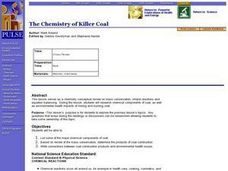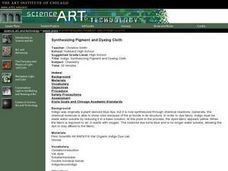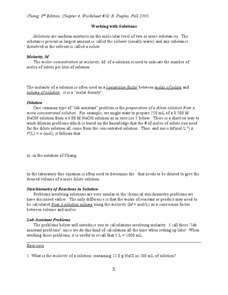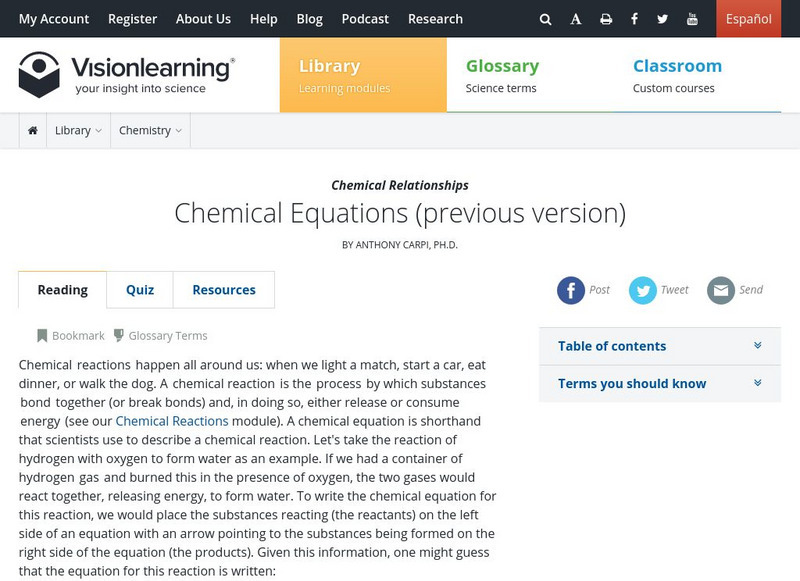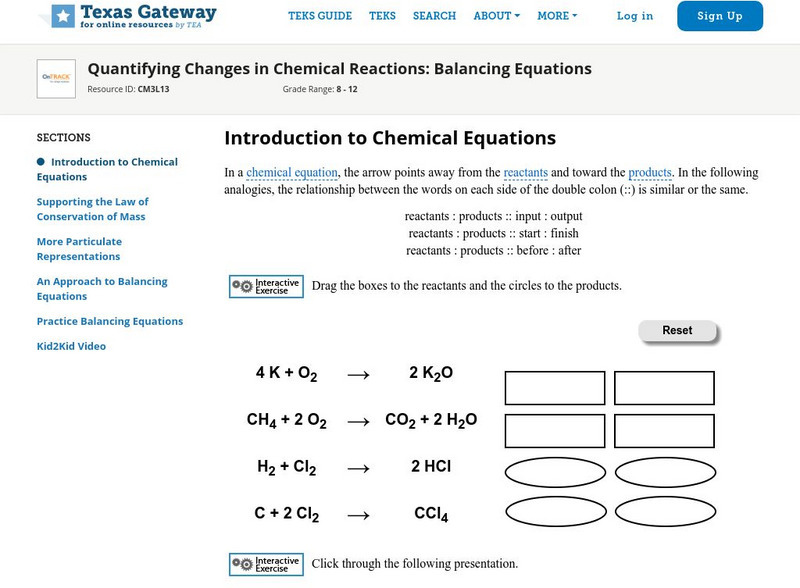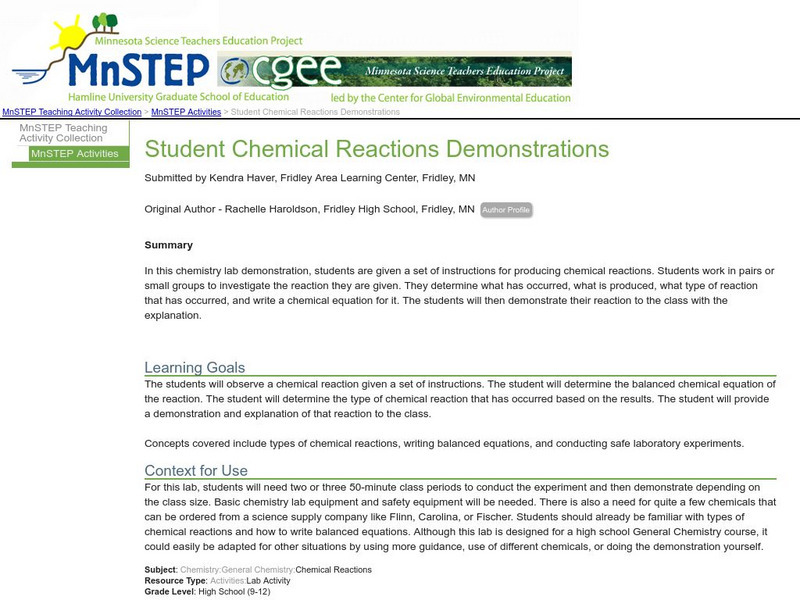Curated OER
The Chemistry of Killer Coal
Students research chemical components of coal, as well as environmental health impacts of mining and burning coal. They discuss conservation of mass as it relates to combustion of organic compounds.
Curated OER
Chemical Stoichiometry Problems
In this stoichiometry worksheet, learners calculate theoretical yield and percent yield. This worksheet has 2 problems to solve.
Curated OER
pH and Titration
For this pH worksheet, students review the titration procedure and the significance of the stoichiometric point. This worksheet has 2 problems to solve.
Curated OER
Synthesizing Pigment and Dyeing Cloth
Students create a synthetic dye and oxidize the dye and record the effects.
Curated OER
Micro-Magic With Sticky Ions
Young scholars view a video about the formation of precipitates. They complete a worksheet that asks them to identify what makes a compound form and what holds it together.
Curated OER
Kidney and Related Concepts
In this kidneys instructional activity, students review the function of the kidneys including what happens when the kidneys stop working. Students also compare kidney function in fish, frogs, and kangaroo rats. This instructional...
Curated OER
Sugar Bush Sap Production - Human Environmental Impact on Sap Sand
Eleventh graders compare the amount of sugar sand present in tree sap. In this environmental science lesson, 11th graders measure different tree circumference. They prepare a report and share findings in class.
Curated OER
Chemistry Review
In this chemistry overview worksheet, learners review stoichiometry, states of matter, thermochemistry, gas laws, chemical bonding, molarity, chemical equilibria, and kinetics. This worksheet has 41 problems to solve.
Curated OER
Photosynthesis and Respiration
Eighth graders differentiate photosynthesis and respiration. In this biology lesson, 8th graders draw a diagram explaining these two processes. They answer a quiz after the lesson.
Curated OER
What is the Thermal Depolymerization Process?
Young scholars examine the differences between Boyle's Law and Charles' Law. They discuss the concept of thermal depolymerization. They answer discussion questions to end the lesson.
Curated OER
Acid Rain
Students investigate the quality of water using a variety of methods. They use a pH probe to measure the pH and study the effect of dissolved CO2 in the water. Students also observe the effect of the pH upon the dissolving of H2SO4 in...
Curated OER
Working with Solutions
In this solutions worksheet, students review how molarity is calculated and how to prepare a dilute solution. This worksheet has 5 problems to solve.
Curated OER
Calorimetry Exercises
For this calorimetry worksheet, students determine the specific heat and the heat of neutralization in the 2 problems they solve.
Curated OER
Chemical Bonding
Eighth graders identify the three main types of chemical bonds. In this chemistry lesson, 8th graders draw Lewis dot diagrams of elements and determine the bond formed. They create a model water molecule.
Curated OER
Cycles Review
Eighth graders discuss the four major cycles of matter. In this general science instructional activity, 8th graders decide which of the four is the most important. They share their opinion in class.
Curated OER
Domino Dash
Eighth graders examine the relationship between speed, time and distance. In this motion lesson students complete a lab activity that allows them to calculate average speed.
Concord Consortium
Concord Consortium: Stem Resources: Chemical Reactions
This web-based activity gives students an opportunity to write chemical reactions, balance chemical equations, and explain what is happening during a given chemical reaction. Also addressed is the effects of concentration and temperature...
Texas Education Agency
Texas Gateway: Thermochemical Equations
Given descriptions, diagrams, scenarios, or chemical symbols, students will calculate the energy changes and identify exothermic and endothermic reactions.
Vision Learning
Visionlearning: Chemical Relationships: Chemical Equations
An introduction to chemical reactions and an explanation of balanced equations.
Texas Education Agency
Texas Gateway: Balancing Equations
Learn how to balance equations in this tutorial. Tutorial includes videos, interactive activities, and practices.
Science Education Resource Center at Carleton College
Serc: Mn Step: Student Chemical Reactions Demonstrations
A lab activity where students conduct and analyze assigned chemical reactions, then demonstrate and explain them to the class. Comprehensive lab handouts are included.
American Chemical Society
Middle School Chemistry: Controlling Amount of Products in a Chemical Reaction
Students analyze the chemical equation for the reaction between vinegar and baking soda. They observe that the gas produced in the reaction is also part of the products of the written chemical equation.
CK-12 Foundation
Ck 12: Balancing Redox Reactions
[Free Registration/Login may be required to access all resource tools.] In the following online tutorial students will balance a redox equation using the oxidation-number-change method. They will break the equation down into oxidation...
CK-12 Foundation
Ck 12: Net Ionic Equations
[Free Registration/Login may be required to access all resource tools.] Students write net ionic equations for double-replacement reactions that produce precipitates, gases, or molecular compounds, write net ionic equations for...
